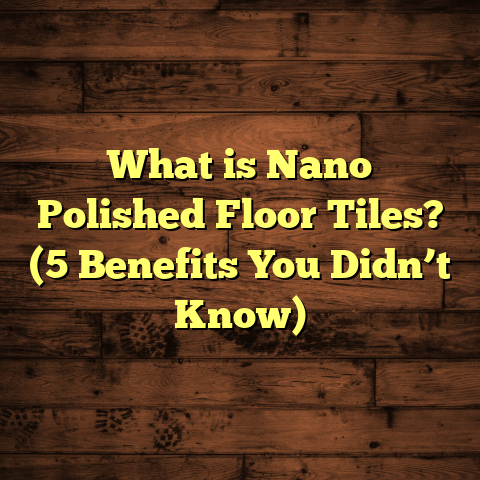What is Porcelain Flooring? (5 Benefits for Your Home)
When I first started thinking about flooring options for my home,
I was really drawn to making eco-conscious choices.
Sustainability wasn’t just a buzzword for me; it felt like a
commitment to reducing my environmental footprint while still
getting something beautiful and durable. That’s when porcelain
flooring caught my eye. Over the years, I’ve learned a lot about
it, tried it in my own projects, and seen firsthand why it’s such
a fantastic option. Let me share what I know.
What is Porcelain Flooring?
Porcelain flooring is a type of ceramic tile made from a refined clay,
which is fired at extremely high temperatures—usually above 1,200°C.
This process creates a dense, hard material that is less porous than
standard ceramic tiles. Because of this, porcelain tiles are very
durable and resistant to moisture.
Unlike regular ceramic tiles, which are often glazed on the surface
only, porcelain tiles can be either glazed or unglazed. The unglazed
varieties have color and pattern through the entire tile, which means
scratches or chips are less noticeable. The glazed ones offer more
design options with glossy or matte finishes.
To put it simply: porcelain flooring is a premium type of tile that’s
built to withstand wear and tear, making it ideal for both residential
and commercial spaces.
I remember when I installed porcelain tiles in my kitchen—my goal was
to combine style with durability. The high density of porcelain makes it
resistant to stains and scratches, which fits perfectly with my busy
household.
Let’s break this down further by understanding how porcelain fits into the bigger picture of flooring materials.
Porcelain Flooring in the World of Tiles: Ceramic vs. Porcelain
You might wonder how porcelain differs from regular ceramic tile or other flooring types like natural stone or vinyl. The main difference lies in composition and manufacturing technique.
- Ceramic Tiles: Made from natural clay but fired at lower temperatures (around 1,000°C). Ceramic tiles tend to be more porous and less dense.
- Porcelain Tiles: Fired at higher temperatures with refined clay and additives that make them dense and almost impervious to water.
- Natural Stone Tiles: Includes granite, marble, slate—each naturally varying in porosity and durability.
- Vinyl Flooring: Synthetic material mimicking wood or stone but lacks the natural hardness of tile.
- Laminate Flooring: Composed of fiberboard layers topped with an image layer protected by a clear coat; less durable against moisture.
In my experience working with multiple flooring types, porcelain stands out because it combines the natural look of stone or wood with the easy maintenance of tile. It’s a solid middle ground between expensive natural stone and less durable synthetic options.
How Porcelain Tiles Are Made: A Closer Look at the Manufacturing Process
The manufacturing process of porcelain flooring involves mixing fine clay with other natural materials like sand and feldspar. This mixture is then pressed under high pressure before being fired in a kiln. The intense heat vitrifies the material—meaning it becomes glass-like and non-porous.
Step-by-Step:
- Raw Material Preparation: Clays are mixed with silica, feldspar, kaolin, and sometimes other minerals.
- Shaping: Using hydraulic presses or extrusion machines, tiles are formed into specific shapes.
- Drying: Tiles are dried carefully to avoid cracks.
- Firing: High-temperature kiln firing (1,200-1,400°C) vitrifies the tile, making it dense.
- Finishing: Tiles may be glazed or polished depending on design requirements.
The vitrification process is what sets porcelain apart from other ceramics, giving it:
- Exceptional hardness (measured at around 7 on the Mohs scale)
- Low water absorption rate (less than 0.5%)
- Superior resistance to frost and chemicals
Because of these properties, porcelain tiles last longer and require less maintenance.
Types of Porcelain Tiles: Which One is Right for You?
Porcelain flooring comes in several types based on surface finish and manufacturing methods:
1. Glazed Porcelain Tiles
These have a protective coating fused onto the surface during firing. Glazing allows for a variety of colors and patterns—anything from matte to shiny finish. It also adds extra protection against stains.
Where I used it: In my bathroom renovation, I used glazed porcelain tiles because they’re easier to clean and have great stain resistance.
2. Unglazed (Through-Body) Porcelain Tiles
The color and pattern run through the entire thickness of the tile. This means scratches don’t show up easily since the material beneath matches the surface color.
Best for: High traffic areas like entryways or kitchens where durability matters most.
3. Polished Porcelain Tiles
These have been ground and polished after firing to create a glossy finish that resembles natural stone like marble.
Upside: Elegant look with reflective surface.
Downside: Can be slippery when wet; best used with anti-slip treatments or in low moisture areas.
4. Textured Porcelain Tiles
Designed with a rougher surface for better traction—ideal for outdoor patios or pool surrounds.
The Science Behind Porcelain’s Durability
I’ve always been curious why porcelain is so tough compared to other materials. It’s all about its physical and chemical properties:
- Hardness: Porcelain ranks high on the Mohs hardness scale (about 7), meaning it resists scratches better than hardwood floors (around 3-4).
- Density: Porcelain is compact with minimal pores, making it resistant to moisture penetration.
- Thermal Resistance: Porcelain handles heat well without cracking—great for heated floors or sunny rooms.
- Chemical Resistance: Household cleaners, acids, and alkaline substances don’t easily damage porcelain.
These features come from its vitrification process during manufacturing.
Detailed Benefits of Porcelain Flooring for Your Home
1. Durability That Stands the Test of Time
I can’t stress enough how durable porcelain tiles are. My own kitchen floor has endured spilled wine, dropped utensils, and heavy foot traffic without showing signs of wear.
According to data from the Tile Council of North America:
- Porcelain tiles have an average lifespan exceeding 50 years with proper care.
- They maintain their color and finish far longer than many other floorings.
- They resist chipping better than ceramic or softer stones.
If you want floors that last decades without needing replacement or refinishing, porcelain is an excellent choice.
2. Water Resistance Makes It Perfect for Wet Areas
The water absorption rate of porcelain tiles is below 0.5%, compared to ceramic tiles which absorb between 3-7%. This means porcelain rarely absorbs moisture that could cause warping or mold growth.
In my experience installing porcelain in bathrooms and kitchens:
- Spills wipe up effortlessly without staining.
- No worries about water damage under sinks or near showers.
- Ideal for basements where moisture can be an issue.
Some homeowners even use porcelain tiles outdoors because they resist frost damage better than other materials.
3. Style Versatility to Match Any Design
Porcelain has evolved beyond simple square tiles in white or beige. Thanks to advances in printing technology:
- You can get wood-look porcelain tiles that mimic oak, walnut, or bamboo.
- Marble-look options offer luxurious veining without high maintenance.
- Patterned designs like encaustic styles bring vintage charm.
- Large-format tiles create modern seamless floors with fewer grout lines.
I once worked on a client project where they wanted natural stone aesthetics but worried about upkeep costs. We chose wood-look porcelain planks that gave warmth and texture while being waterproof and scratch-resistant—a win-win!
4. Hypoallergenic and Easy to Maintain
For families prone to allergies like mine, flooring that doesn’t trap dust mites or allergens is key.
Porcelain tiles’ hard surface prevents accumulation of allergens like pet dander or pollen compared to carpet or fabric-covered floors.
Maintenance is straightforward:
- Sweep or vacuum regularly to remove dust.
- Mop occasionally with mild detergent.
- Avoid harsh scrubbing or abrasive materials that could dull finishes.
I’ve found that even after years of use, glazed porcelain floors still look almost new with simple care routines.
5. Eco-Friendly Benefits
Choosing sustainable materials has become part of my flooring decisions.
Porcelain flooring supports eco-conscious goals because:
- It’s made from abundant natural clays without toxic chemicals.
- Many manufacturers incorporate recycled content into their products.
- Its durability means fewer replacements over time—less waste.
- At end-of-life, porcelain can be crushed and recycled as aggregate for construction projects.
- It doesn’t require chemical sealers or finishes that might release VOCs (volatile organic compounds).
A life cycle assessment study I reviewed showed that compared with vinyl flooring, porcelain’s environmental impact over 50 years was significantly lower due to its longevity and inert materials.
Installation Insights: What You Should Know Before You Start
Installing porcelain tiles can be more challenging than some other floorings because of their density and hardness.
Here’s what I’ve learned through personal projects and working alongside installers:
Tools You Need
- Wet saw with diamond blade (for precision cutting)
- Notched trowel for applying thinset mortar
- Rubber mallet for leveling
- Grout float for finishing joints
Subfloor Preparation
Porcelain is heavier than ceramic or laminate floors—so your subfloor needs to be strong,
stable,
and level to avoid cracking later on.
If installing over plywood,
make sure it’s thick enough (usually at least 3/4”),
and free from movement.
For concrete slabs,
check for moisture issues before installation.
Installation Process Overview
- Lay out your tile pattern to minimize cuts.
- Spread thinset mortar evenly on subfloor using notched trowel.
- Press each tile firmly into mortar bed.
- Use spacers for uniform grout lines.
- Allow mortar to cure (typically 24 hours).
- Apply grout between tiles, wiping excess immediately.
- Seal grout lines if recommended by manufacturer.
From experience,
rushing any step leads to uneven surfaces or loose tiles later on,
so patience pays off here!
Cost Considerations: Budgeting for Porcelain Flooring Projects
One common question friends ask me is,
“How much does porcelain flooring cost?”
Let’s break down typical expenses based on my research and personal projects:
| Expense Component | Typical Range (USD) | Notes |
|---|---|---|
| Material Cost | $3 – $10 per sq ft | Depends on tile style/size/brand |
| Labor Cost | $5 – $15 per sq ft | Varies by complexity & region |
| Subfloor Prep | $1 – $3 per sq ft | If needed |
| Grout & Sealants | $0.50 – $2 per sq ft | Depending on product quality |
| Waste Factor | 5% – 10% extra material | To cover cuts & breakage |
For example,
a 500-square-foot kitchen might cost anywhere from $4,000 to $12,000 total installed,
depending on tile quality & labor rates where you live.
What helped me immensely is using FloorTally,
an online tool that consolidates local labor rates,
material costs,
and waste factors into one estimate,
saving me hours of phone calls and guesswork.
It gave me confidence knowing our budget was realistic before ordering materials or scheduling installers.
Comparing Porcelain Flooring With Other Popular Options
If you’re weighing your options between flooring types,
here’s how porcelain stacks up:
| Feature | Porcelain Tile | Hardwood Flooring | Laminate Flooring | Vinyl Flooring |
|---|---|---|---|---|
| Durability | Very High | Moderate | Moderate | Moderate |
| Water Resistance | Excellent | Poor | Poor | Good |
| Maintenance | Low | Moderate | Low | Low |
| Cost (Material + Labor) | Moderate – High | High | Low – Moderate | Low |
| Appearance Variety | Very High | Natural Wood Grain | Wood/Stone Look | Wood/Stone Look |
| Eco-Friendliness | Good | Depends on source | Low | Low |
From personal experience,
I’ve seen hardwood floors scratch easily with kids and pets,
and laminate tends to peel or swell near moisture areas.
Porcelain offers a good balance between aesthetics,
durability,
and ease of care,
especially in kitchens & bathrooms.
Maintenance Tips: Keeping Your Porcelain Floor Looking New
To keep your porcelain floor in tip-top shape over the years,
here’s what I do (and recommend):
- Sweep/vacuum regularly to remove grit that can cause scratches.
- Mop using warm water mixed with mild detergent every week or two.
- Avoid acidic cleaners like vinegar which can dull glaze over time.
- Use soft cloths or mops rather than abrasive scrubbers.
- Clean spills immediately to prevent grout staining.
- Reseal grout lines every few years if needed (some grouts are epoxy-based & don’t require sealing).
I’ve noticed that sticking to these simple habits keeps my floors bright and scratch-free even after heavy use.
Real-Life Case Study: Transforming a Living Room with Porcelain Tiles
One project stands out in my memory—a living room renovation where the client wanted something stylish but practical for their active family.
We selected large-format polished porcelain tiles mimicking dark slate stone with subtle textures for slip resistance.
Using FloorTally helped us estimate costs precisely before ordering:
- Material cost was mid-range but offered premium looks.
- Labor costs were controlled by choosing a simple grid pattern layout.
- Waste factor was low due to precise cutting plans.
After installation,
the family reported:
- Easy cleaning after kids’ playdates
- No visible wear after one year despite pet traffic
- Compliments from visitors on the elegant floor
This project showed me how combining good planning tools with quality materials leads to happy clients and great results.
Environmental Impact: How Sustainable is Porcelain Flooring?
Since eco-consciousness drives many decisions nowadays,
I researched porcelain’s environmental footprint extensively.
Key Points:
- Made from abundant natural minerals without synthetic additives.
- Manufacturing uses high-temperature kilns consuming energy but produces long-lasting products that minimize replacement waste.
- Some brands incorporate recycled materials into tile production reducing raw material extraction.
- No chemical sealants needed post-installation which lowers indoor air pollution risks.
- End-of-life recycling possible by crushing tiles into construction aggregates.
A lifecycle assessment study comparing various flooring types concluded porcelain scored well overall due to longevity offsetting higher initial manufacturing energy use compared to vinyl or carpet.
Design Inspiration: Creative Ways People Use Porcelain Flooring
Beyond functional benefits,
porcelain offers incredible creativity possibilities:
Wood-Look Tiles for Warmth Without Worry
I love recommending wood-look porcelain planks for those who want hardwood style but need water resistance in kitchens or basements.
They come in various grains and colors—from light oak to deep walnut—and feel surprisingly authentic underfoot.
Patterned Tiles for Artistic Flair
From retro encaustic patterns to Moroccan-inspired mosaics,
patterned porcelain can add character to entryways or powder rooms without sacrificing durability.
I installed Moroccan-style patterned tiles in a client’s foyer last year—they loved how easy it was to clean yet bold enough to impress guests immediately upon entry.
Large Format Tiles for Seamless Modern Floors
Big slabs reduce grout lines creating a sleek minimalist look perfect for open-concept spaces.
My own living room uses 24×24 inch polished porcelain giving an airy feel while standing up well against furniture scratches.
Troubleshooting Common Issues With Porcelain Floors
Although porcelain is tough,
there are some challenges you might encounter:
Cracking Due to Subfloor Problems
If your subfloor isn’t flat or stable,
tiles may crack over time due to movement underneath.
That’s why I always emphasize thorough subfloor inspection before installation.
Slippery Surfaces When Wet
Polished porcelain can be slippery if water sits on the surface,
so adding textured finishes or anti-slip coatings helps in bathrooms or kitchens.
Grout Discoloration
Grout lines may get dirty faster than tiles themselves,
so regular cleaning and using stain-resistant grout products help maintain appearance.
Final Thoughts on Porcelain Flooring Choices
Porcelain flooring offers a blend of strength, style, sustainability,
and ease of maintenance that few other flooring materials match.
Whether you want something that lasts decades,
need water resistance for wet rooms,
or want endless design possibilities,
porcelain delivers consistently based on my experience and research.
If you’re planning a home renovation,
consider spending time upfront exploring tile options,
using tools like FloorTally for budgeting accuracy,
and consulting professionals experienced in handling this material well.
Have you tried porcelain flooring yet?
What was your experience?
I’d love to hear your thoughts!




